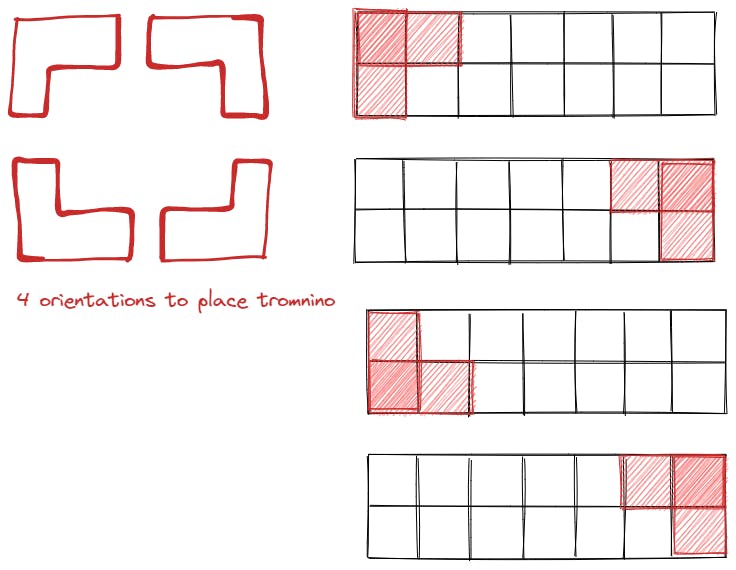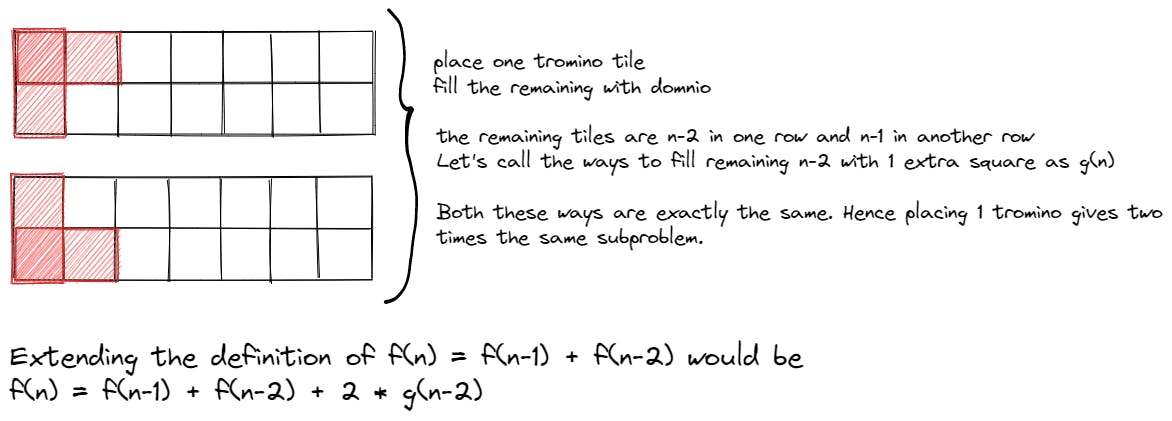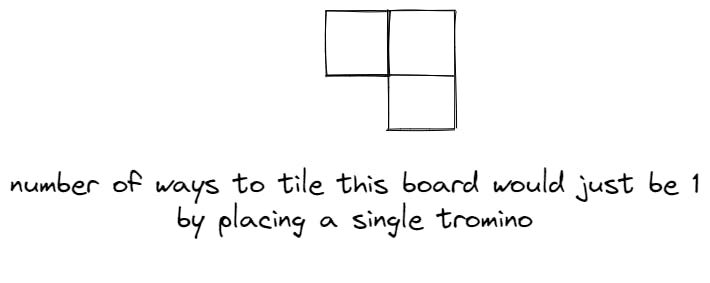Hello, reader 👋🏽 ! Welcome to day 84 of the series on Problem Solving. Through this series, I aim to pick up at least one question every day and share my approach to solving it.
Today, I will be picking up LeetCode's daily challenge problem: 790. Domino and Tromino Tiling.
🤔 Problem Statement
You have two types of tiles: a
2 x 1domino shape and a tromino shape and they can be rotated.Given an integer n, return the number of ways to tile an
2 x nboard. Since the answer may be very large, return it modulo10<sup>9</sup> + 7.In a tiling, every square must be covered by a tile. Two tilings are different if and only if there are two 4-directionally adjacent cells on the board such that exactly one of the tilings has both squares occupied by a tile.
E.g.:
n=1=>1n=3=>5
💬 Thought Process - Brute Force
This is a dynamic programming problem where we will have to try out all the possible ways of placing the given two tiles: domino and tromino, and return the total ways.
But we do need to find out some way to represent and figure out ways to place tiles.
Let's first focus on placing domino tiles. We'll take care of ways to place one tile both horizontally and vertically.
- Look at the image below that places domino tile horizontally and vertically

Hence, placing a domino tile would have two options and our subproblem reduces to
f(n) = f(n-1) + f(n-2)
What about tromino? Well tromino is the trickiest part.
Before I explain ways to place tromino tiles, let's look at the possible orientations:

Symmetrically, if we place trominoes in any of the above orientations the subproblems left to solve would be the same.
- That is either the top or bottom row with an extra square
Now that we have looked into the possible orientations, let's see the ways that we can actually place these tiles.
Again, we'll try to place one tromino tile and look at the possible ways to fill the remaning board.

We are done with the main function, but what of
g(n)? We don't know how this is defined.Let's try to find how to define
g(n)by building from the previous problem where we placed 1 tromino tile.
Hence, our final equations boil down to this:
f(n) = f(n-1) + f(n-2) + 2 * g(n-2) g(n) = f(n-1) + g(n-1)Now for the base cases:
for
fthe base cases would be:f(0)the number of ways to tile are0f(1)the number of ways to tile are1f(2)the number of ways to tile are2
for
gthe base cases would be:g(0)the number of ways are0g(1)the number of ways are1Why? Well let's visualise how
g(1)would look like on the board:
This is becasuse as stated earlier,
g(n)would have columns in one row and the other row withn+1columns.
Hence, the final solution would be:
```java class Solution {
int mod = (int) (1e9 + 7); public int numTilings(int n) { return (int) numTilingsHelper(n) % mod; } private long numTilingsHelper(int n) { if(n <= 0) return 0l; if(n <= 2) return n;
// f(n-1) + f(n-2) + 2*g(n-2)
long vert = numTilingsHelper(n-1) % mod;
long hor = numTilingsHelper(n-2) % mod;
long tro = numTilingsTromino(n-2) % mod;
return (vert + hor + 2 * tro) % mod;
}
private long numTilingsTromino(int n) {
if(n <= 0) return 0l;
if(n == 1) return 1l;
// g(n) = g(n-1) + f(n-1)
long hor = numTilingsTromino(n-1) % mod;
long tro = numTilingsHelper(n-1) % mod;
return (hor + tro) % mod;
}
}
```
Now, we cannot simply use this as the final solution because we have multiple sub problems. The worst time complexity would be
O(3^N).We can do better and it's not very diffiult to see that there are going to be subproblems.
Also note how we are using
longinstead ofinthere as return values. This is necessary since we could be dealing with numbers outside ofintrange.
💬 Thought Process - Memoization
- There is only one dependent state:
n. But we would require two different arrays to cache values. One to solve and cache sub-problems forf(n)and the other to cache and solve sub-problems forg(n).
👩🏽💻 Solution - Memoization
class Solution {
int mod = (int) (1e9 + 7);
long[] memo, tromino;
public int numTilings(int n) {
memo = new long[n+1];
tromino = new long[n+1];
Arrays.fill(memo, -1);
Arrays.fill(tromino, -1);
return (int) numTilingsHelper(n) % mod;
}
private long numTilingsHelper(int n) {
if(n <= 0) return 0l;
if(n <= 2) return n;
if(memo[n] != -1) return memo[n] % mod;
// f(n-1) + f(n-2) + 2*g(n-2)
long verticalTile = numTilingsHelper(n-1) % mod;
long horizontalTile = numTilingsHelper(n-2) % mod;
long trominoTile = numTilingsTromino(n-2) % mod;
return memo[n] = (verticalTile + horizontalTile +
2 * trominoTile) % mod;
}
private long numTilingsTromino(int n) {
if(n <= 0) return 0l;
if(n == 1) return 1l;
if(tromino[n] != -1) return tromino[n];
// g(n) = g(n-1) + f(n-1)
long horizontalTile = numTilingsTromino(n-1) % mod;
long trominoTile = numTilingsHelper(n-1) % mod;
return tromino[n] = (horizontalTile + trominoTile) % mod;
}
}
Time Complexity: O(n)
Space Complexity: O(n)
💬 Thought Process - Tabulation
- We can convert the above solution to tabulation. Instead of recursive calls, we can use loops to calculate for the current value of
nusing previous solved sub-problems.
👩🏽💻 Solution - Tabulation
class Solution {
int mod = (int) (1e9 + 7);
public int numTilings(int n) {
if(n == 0) return 0;
if(n <= 2) return n;
long[] dp = new long[n+1];
long[] tromino = new long[n+1];
dp[0] = 0;
dp[1] = 1;
dp[2] = 2;
tromino[0] = 0;
tromino[1] = 1;
tromino[2] = 2;
for(int i = 3; i<=n; i++) {
dp[i] = (dp[i-1] + dp[i-2] + 2 * tromino[i-2]) % mod;
tromino[i] = (tromino[i-1] + dp[i-1]) % mod;
}
return (int) dp[n];
}
}
Time Complexity: O(n)
Space Complexity: O(n)
💬 Thought Process - Space Optimization
We need only the answers to the two previous sub-problem for
f(i)and one previous sub-problem forg(i).Hence we can use variables and keep updating them instead of using an entire array.
We'll call the previous two states of the main sub-problem
f()asfirstTilingandsecondTiling.For the tromino tiling sub-problem, let's call the first and second state as
firstTrominoandsecondTromino.Each time we solve a sub-problem, we'll update
firstTilingto the value ofsecondTilingandsecondTilingto the value of the current answer of sub-problem.Similarly, each time we solve a sub-problem for the tromino tiling case, we'll update
firstTrominoto the value ofsecondTrominoand thesecondTrominoto the value of the current answer of sub-problem.Finally, we can return the answer in the
secondTilingvariable.
👩🏽💻 Solution - Space Optimization
class Solution {
int mod = (int) (1e9 + 7);
public int numTilings(int n) {
if(n == 0) return 0;
if(n <= 2) return n;
long firstTiling = 1;
long secondTiling = 2;
long firstTromino = 1;
long secondTromino = 2;
for(int i = 3; i<=n; i++) {
long currentTiling = (firstTiling + secondTiling +
2 * firstTromino) % mod;
long currentTromino = (secondTromino + secondTiling) % mod;
firstTiling = secondTiling;
secondTiling = currentTiling;
firstTromino = secondTromino;
secondTromino = currentTromino;
}
return (int) secondTiling;
}
}
Time Complexity: O(n)
Space Complexity: O(n)
💬 Thought Process - Breaking down the equation
So far, our equations are as follows:
f(n) = f(n-1) + f(n-2) + 2 * g(n-2) --- #1 g(n) = f(n-1) + g(n-1) --- #2Turns out, this could further be shortened to avoid the extra
g(n)variable function.We'll understand how this works.
Before that let's see what the value of
g(n-2)would be:g(n-2) = f(n-3) + g(n-3)Using the above equation in the
#1we get:f(n) = f(n-1) + f(n-2) + f(n-3) + g(n-3) + f(n-3) + g(n-3)This can be regrouped as:
f(n) = f(n-1) + f(n-3) + [f(n-2) + f(n-3) + g(n-3) + g(n-3)]The equation:
f(n-2) + f(n-3) + g(n-3) + g(n-3)is basically the value off(n-1)Hence, we arrive at:
f(n) = f(n-1) + f(n-3) + f(n-1) f(n) = 2 * f(n-1) + f(n-3)Hence, we'll use three variables:
firstTiling,secondTilingandthirdTiling. Initially,firstTilingwill be equal tof(1) => 1,secondTilingwill be equal tof(2) => 2, andthirdTilingwill be equal tof(3) => 5.We'll loop from
n=4to calculate future sub-probllems and finally return the value inthirdTiling.
👩🏽💻 Solution - Breaking down the equation
class Solution {
int mod = (int) (1e9 + 7);
public int numTilings(int n) {
if(n == 0) return 0;
if(n <= 2) return n;
long firstTiling = 1; // f(1)
long secondTiling = 2; // f(2)
long thirdTiling = 5; // f(3)
for(int i = 4; i<=n; i++) {
// 2 * n-1 + n-3
long currentTiling = ((2 * thirdTiling) + firstTiling) % mod;
firstTiling = secondTiling;
secondTiling = thirdTiling;
thirdTiling = currentTiling;
}
return (int) thirdTiling;
}
}
Time Complexity: O(n)
Space Complexity: O(n)
- You can find the link to all the four solutions on the GitHub for this question here: 790. Domino and Tromino Tiling.
Conclusion
That's a wrap for today's problem. If you liked my explanation then please do drop a like/ comment. Also, please correct me if I've made any mistakes or if you want me to improve something!
Thank you for reading!
